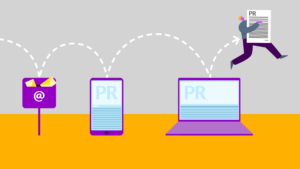Trade shows are a great way to showcase a new product or talk to people in your industry about an idea. You also could line up investors. But, do you know that trade shows also are great ways to meet journalists and build a relationship with the? You should take steps before the show, during the show, and after the show. This three-part series will explain what you need to know to help journalists attending the trade show know you and your product. Part 2 describes the steps during the show.
by Louise Harris
Business owners know that a great way to demonstrate a new product is to exhibit at a trade show. Entrepreneurs with ideas also attend trade shows. They might exhibit at a show if their idea has made it to a prototype or if it is being launched. Journalists also attend trade shows. They are looking for stories in their beat. They also want to meet business owners and talk with them. They want to see new products that might spur their interest for a story. To maximize your return on your trade show investment, you want to alert journalists and investors attending the show. During the trade show, you want to make time for journalists who are attending. Take these steps to associate with journalists at the show.
1 – Go to the Press Room
Large conferences always have a room dedicated to journalists working the trade show. This room usually has computers because some journalists don’t bring theirs or leave a laptop in their hotel room for writing the stories. During the show hours, they go to the press room to check e-mail, social media and their voice mail. They might return phone calls in that room. If you have a new product or service or you want to pitch a story idea, you should go to this press room during the show. You might not have a lot of time, but you could go during breaks or before the exhibit hall opens for the day. Talk to the journalists in the room. Hand out your business card.
2 – Invite Journalists to Your Booth
When you talk with them in the press room or after a speech, you should invite them to visit your booth. Talk about what they can expect to find when visit you at your booth. Give them a general idea of the product or story idea. When they visit your booth, hand them your press kit and ask if they have questions you could answer. Set an appointment where they can talk to the executives and project managers to provide more information for the story.
3 – Create a Press Corner
In your booth, create an area dedicated to journalists who visit. Have your press kits available at this section. If you don’t know how to create a media kit, you can read our related article. Also, appoint an employee who could be dedicated to talking with journalists and not others at the show. Collect their business cards but keep them separate from the rest of the names who are potential customers or investors. Let your employee schedule times journalists can come back to talk to executives about the product, service or story idea. Provide journalists coffee, water and snacks. They are working long hours at the show the same as the exhibitors.
4 – Set Aside Time
Make sure you set aside time for journalists to meet with your chief executive officer and project manager. This should be time dedicated to journalists and not to gathering leads for sales or investors. Answer all their questions and provide background. If your CEO is speaking at the trade show, tell the journalists when it will happen and what room number it is. Invite them to be in the audience during the speech so they could learn more.
5 – Go to Receptions
Most large trade shows have one or more receptions arranged. Journalists attend the receptions regularly. They get great stories from people who are more relaxed during these receptions. They will answer questions without inhibitions. They also will not always use the company line. Journalists often hear something from the speeches they want to confirmed or they want to find out more about what they heard. Often, the answers are provided during the receptions. When you go to the reception, you could be quoted as an expert on the topic journalists want. They will talk with you and mention your product, company and title in the story. Feel free to talk about issues in your industry during these receptions. If the conference organizers don’t have any receptions established, you could ask the hotel to have one. You rent a suite and invite members of the show, journalists and investors back to your suite. Then, talk about what you feel is important that you want journalists to know.
6 – Take a Journalist to Dinner
When covering a large trade show, journalists often spend eight or nine hours taking notes about the speeches, products, companies and issues affecting the industry. They spend another four hours writing stories about what they heard. The only break they get usually is dinner. If you have a great idea, invite a journalist to spend dinner with you. Help him or her relax from the long hours. Get to know him or her in a setting that isn’t work and begin to build a relationship. The journalists will appreciate this act of kindness.
7 – Post to Social Media
Keep a constant update going on your social media about your experiences during the show. Journalists check these for ideas and pictures. Add photos and ask people to share.
Speaking or exhibiting at a trade show is newsworthy. You want to maximize your return on your trade show investment, so make sure you get help with your press releases and media exposure. If you work with experts, like Faselis Growth, you will be able to make your show experience beneficial. You might be getting media coverage for your prototype.
In the next article, we will discuss what you want to do when the trade show ends for follow-up.








